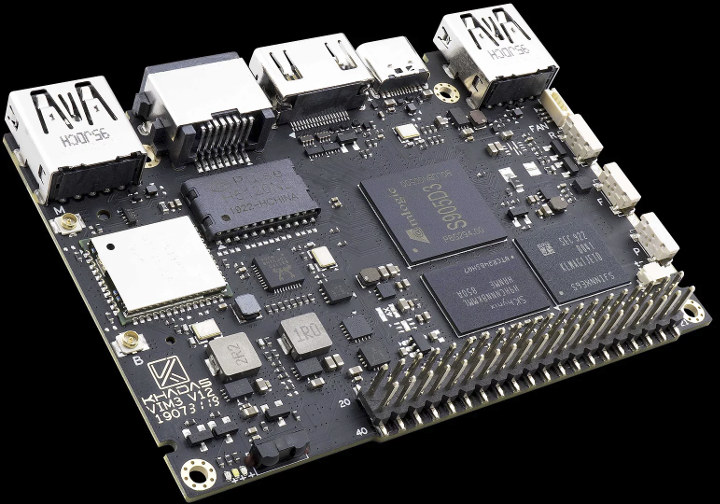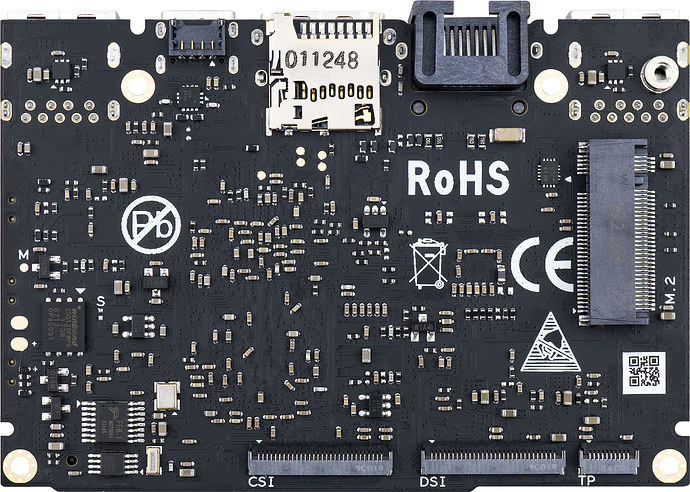Khadas recently launched VIM3 single board computer powered by Amlogic A311D that delivers the best performance among Arm-based SBC’s I have tested myself, and for instance, Amlogic A311D is significantly faster than Rockchip RK3399, and the platform is quite suitable for Android gaming.
All that power comes at a price however, as Khadas VIM3 starts at $99.99 with 2GB RAM and 16GB storage. That’s fine if you’re going to leverage the features and power of the board, but for some applications, it’s quite expensive. One of those applications is HTPC, as in a world of sub-$50 TV boxes, $100 is a bit too much for watching video content. So the Khadas team is currently developing Khadas VIM3L based on Amlogic S905D3 processor that should provide an excellent platform for HTPC.

Khadas VIM3L specifications known so far:
- SoC – Amlogic S905D3-N0N quad-core Cortex-A55 processor @ 1.9GHz with Arm Mali-G31MP2 GPU up to 800MHz supporting OpenGL ES 3.2, Vulkan 1.0 and OpenCL 2.0, real-time Cortex-M4 core for always-on processing, and 1.2 TOPS NPU (See datasheet for details)
- System Memory – 2GB LPDDR4/4X
- Storage – 16GB eMMC 5.1 flash, 16MB SPI flash, microSD card slot (SDSC/SDHC/SDXC), M.2 NVMe SSD supported (See Expansion for details)
- MCU – STMicro STM8S003 with programmable EEPROM
- Video Output / Display I/F-
- HDMI 2.1 transmitter with 3D, Dynamic HDR, eARC, CEC, and HDCP 2.2 support
- 4-lane MIPI DSI Interface up to 1920×1080
- 10-pin 0.5mm pitch FPC connector for touch panel
- Video
- UHD 4K H.265 75fps 10-bit video decoder & low latency 1080p H.265/H.264 60fps encoder
- Support multi-video decoder up to 4Kx2K@60fps+1x1080P@60fps
- Dolby Vision and HDR10, HDR10+, HLG, and PRIME HDR video processing
- Camera – 2-lane MIPI CSI (ISP not built-in)
- Connectivity – Gigabit Ethernet with Wake-on-LAN support; Ampak AP6398S wireless module with 802.11a/b/g/n/ac WiFI 5 2×2 MIMO with RSDB and Bluetooth 5.0
- USB – 2x USB 3.0 host ports (900mA & 500mA Load), USB 2.0Type-C port with OTG & USB PD support
- Sensor – KXTJ3-1057 3-axis digital accelerometer
- Expansion
- M.2 socket with 1-lane PCIe 2.0, USB 2.0, I2S, I2C, ADC, 100M Ethernet PHY interface, and GPIOs
- 40-pin I/O header with pins accessible from
- CPU – USB, I2C, I2S, SPDIF, UART, PWM, ADC
- MCU – SWIM, NRST, PA1
- Misc
- 2-channel IR receiver
- RTC & battery header
- 4-pin cooling fan header with PWM speed control
- Blue, red and white LEDs
- Power, Func and Reset buttons
- XPWR pads for external power button
- KBI interface to switch between USB 3.0 and PCIe (since both can’t be used at the same time)
- Power Supply – 5V to 20V via USB-C port
- Security – TrustZone based security for DRM video streaming
- Dimensions – 82.0 x 58.0 x 11.5 mm (4x M2 mounting holes)
- Weight – 28.5 grams
- Certifications – CE, RoHS
The company will provide mainline Linux (Linux 5.0+), mainline U-Boot, and the SBC will support Ubuntu 18.04 and Armbian Linux distributions, as well as HTPC-focused firmware such as LibreELEC or CoreELEC, and Android 9.0 operating system. Since Amlogic S905D3 processor is a “D” part we might also have expected support for dual-independent tuners via add-on boards such as VTV Expansion DTV board, but the company did not layout the expansion pads on the bottom of the board like in Khadas VIM2, so it won’t be compatible with the aforementioned expansion board.
Khadas VIM3L will be compatible with the enclosure made for other VIM boards, so you should be able to get a complete kit with the board, enclosure, IR remote control, and power supply. That’s about all we know for now, as availability and pricing have not been disclosed. More information should eventually be posted on the product page and forum announcement.

Jean-Luc started CNX Software in 2010 as a part-time endeavor, before quitting his job as a software engineering manager, and starting to write daily news, and reviews full time later in 2011.
Support CNX Software! Donate via cryptocurrencies, become a Patron on Patreon, or purchase goods on Amazon or Aliexpress





